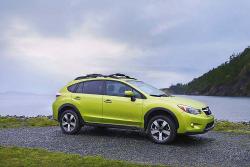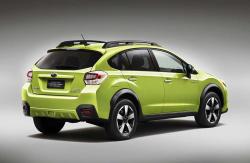 2013 Subaru XV Crosstrek Hybrid. Click image to enlarge |
Preview by Paul Williams, photos by Jonathan Yarkony and courtesy Subaru
An interesting media event at the recent New York International Auto Show was the introduction of Subaru’s first hybrid vehicle, the 2014 XV Crosstrek Hybrid.
I say interesting because Subaru has been battling (with some recent success) the fuel consumption of its boxer engines for a while, now, and a hybrid could make a significant contribution in that endeavour.
The XV Crosstrek is a good platform upon which to base a hybrid. Built on the latest Impreza underpinnings, the XV Crosstrek uses the same 2.0L engine as the Impreza, and already arrives with a continuously variable transmission (CVT) “automatic” (typically, although not always, found in hybrid drivetrains).
The 2014 Subaru XV Crosstrek Hybrid model will arrive at Subaru dealerships during the fourth quarter of 2013.
According to Subaru Canada, the XV Crosstrek Hybrid will offer the same functionality as the gasoline-powered version, sharing same all-wheel drive system and retaining its impressive 220 mm of ground clearance (almost as much as a Jeep Wrangler, and more than most SUVs) while providing a low step-in height.
“The Active Torque Split version of Subaru symmetrical full-time AWD provides the same operation and benefits as in the gasoline model,” reports Subaru. “The system sends power to all four wheels all the time and adjusts the torque distribution in response to acceleration, cornering and road conditions.”
|
2013 Subaru XV Crosstrek Hybrid. Click image to enlarge |
The XV Crosstrek Hybrid does feature some chassis re-engineering, however, to handle the added weight of the battery system. Subaru Canada says that the modifications will actually improve steering, handling and ride. Additionally, Subaru has added extra sound insulation, a start/stop feature, revised heating, ventilation and air conditioning (HVAC) and a new gauge cluster, among other changes.
The 2.0L engine will be combined with a 13.4-hp electric motor that is integrated into the CVT transmission. A 100-volt, 13.5-kilowatt nickel-metal hydride battery is located under a revised rear floor area and the engine uses an integrated starter/generator for the automatic start/stop feature. Note that this system does not use the more modern lithium battery technology now found in hybrid models from several competitors like Ford, Hyundai and Kia.
The hybrid system weighs 95 kg and places the electric motor just behind the transmission and in front of the continuously variable transfer clutch. It adds approximately 136 kg in weight compared with the gasoline engine XV Crosstrek.
Hybrid buyers will want to know if the XV Crosstrek Hybrid can be driven on battery alone, like the Prius, for instance. Subaru says that under light acceleration, the Subaru-engineered hybrid system will use the electric motor for initial vehicle acceleration, starting the gasoline engine once underway.
“The electric motor can also provide motor assist for acceleration in parallel with the gasoline engine,” says Subaru Canada, “and an EV [electric vehicle] mode will operate the vehicle in certain low-speed situations.”
What this suggests is some limited capability to operate continuously in EV mode, and likewise limited battery-only propulsion when starting from a standstill.
 2013 Subaru XV Crosstrek Hybrid. Click image to enlarge |
However, Subaru has optimized its 2.0L, horizontally opposed “Boxer” engine to reduce internal friction and has included other technologies (such as auto start/stop and brake regeneration) to improve fuel efficiency. The auto start/stop system shuts down the gasoline engine when the vehicle is stopped (at a stop light, for instance), and brake regeneration recaptures kinetic energy from the turning wheels when the car is coasting or the driver has applied the brake. It has to be said that both of these latter technologies are typical of modern hybrid vehicles from all manufacturers.









